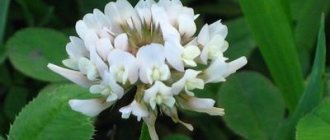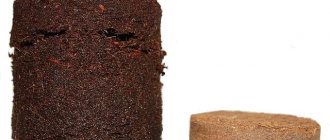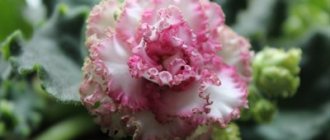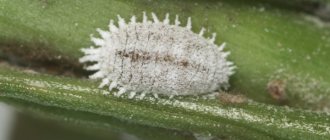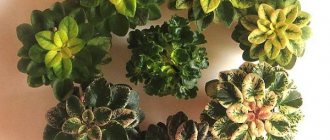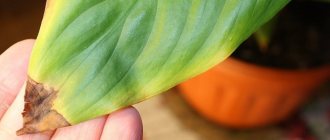Owners of personal plots strive to plant them in accordance with all the rules of landscape design. It's nice to go out into the yard, covered with a natural green carpet. After sowing lawn grass, people are often disappointed because without proper care the sowing does not look aesthetically pleasing. Not everyone knows that you can use white clover for the lawn as the most low-maintenance plant, so let’s look at the features, advantages and disadvantages of the crop, how to plant and maintain a beautiful lawn.
Clover lawn Source woodstar.com.ua
Characteristics
This is a common low-growing plant with creeping stems and branching roots. The branch has three leaves with white streaks. Belongs to the legume family. Since spring, the earth is covered with an elegant bright green carpet. In summer, white flowers appear, which are inflorescences of many small tubular flowers.
During flowering, clover is covered with white fluffy inflorescences Source dary-prirody.su
An unpretentious meadow plant grows throughout Russia. The branched roots go to a depth of 250 cm. The basal system contains buds, which protects the bush from being eaten by animals. Thanks to the activity of bacteria that absorb nitrogen, small tubers appear on the roots. This is the result of a natural symbiosis, as a result of which the plant receives nitrogen from the air and processes it into an easily digestible form.
The perennial is unpretentious to the soil - it grows well both on fertile black soil and on aluminous soil. It does not require frequent watering, it spreads on the surface as a continuous carpet, without forming bald spots, unlike lawn grass.
It blooms twice a year, but blooms for the first time in the second year after sowing the seeds. The first series of flowering occurs from May to August, the second - from August to October.
Botanical description
The main stem is shortened, up to 4 cm long. Axillary ascending shoots extend from it: branched, often hollow, rooting at the nodes, without pubescence. Stipules are clearly visible, membranous, whitish with purple veins. Lanceolate in shape, pointed. Leaves on long ascending petioles, trifoliate. The leaves in three sit on short petioles, are obovate in shape, often notched at the top, finely toothed along the edge, often with a white pattern.
Photo 2. The leaves have a light pattern, small teeth are visible along the edge, and a small notch on top.
Flowering stems, sometimes pubescent on top, ending in a rather loose inflorescence head, usually exceed the leaf petioles in height. Balls about 2 cm in size consist of white, sometimes pale yellow, greenish or pink flowers of a typical legume structure: the petals form the so-called boat, oars (wings), and flag. The wings are slightly more than half the length of the flag, their marigolds (bases) are fused with the boat marigolds and the stamen tube.
The calyx of each flower in the inflorescence is bell-shaped, pale, with ten green veins, with teeth, less than half the size of its entire length. There are purple spots between the teeth. The fruit is a linear bean with 3–4 seeds.
Photo 3. Inflorescence. Violet spots are visible between the green teeth of the whitish calyx.
Structural features that distinguish it from other similar species
Among the representatives of Trifolium, other species with white spherical inflorescences are found in the wild - K. mountain and K. hybrid (Swedish). It is difficult to confuse the first K. repens, since the mountain stem is more powerful, higher, the leaves in trefoils are closer to an elliptical shape, the inflorescence is denser, so its heads seem neater.
Pink varieties of K. repens may look similar to K. hybrida, the latter may also have off-white flowers. To clarify the species, you need to look at the shoots: in a hybrid they are erect, not spread out and not rooted. There is also a difference in the stipules: they are not membranous, like those of Trifolium repens, but herbaceous, green. Using a magnifying glass or a photo with good resolution, you can examine the calyx: a hybrid will have 5 veins on it (C. repens will have 10).
Varieties of white clover
Botanists have developed a large number of plant varieties: Volat, Pipolina, Klondike, Dukhmyany, Ronnie, Sylvester, Rivendell. With such an abundance of varieties, you have to decide which clover to choose for your lawn in order to spend less time on care.
A decorative variety of microclover creates a continuous green carpet Source sadrium.ru
Decorative microclover is gaining popularity thanks to:
- drought resistance;
- elegant evergreen cover;
- strong roots that ensure high growth - there are almost no bald spots, as they quickly overgrow.
Why is white clover good for the lawn?
"White porridge" is widely used in landscape design. The planting quickly forms a fluffy emerald carpet decorating the area. The lawn is pleasing to the eye, suitable for relaxation, and children can frolic on it. Planting is used for:
- designing borders and circles around trees;
- sowing the space between the beds and paths in the garden;
- sowing between stone slabs;
- creating lawns;
- lawns.
Edging a garden path Source lifegazon.ru
See also: Catalog of companies that specialize in landscape design
Next, let's take a closer look at the pros and cons of a clover lawn:
Positive sides
The culture is popular among gardeners due to the following advantages:
- decorative – planting creates a bright green flooring, enlivened by white color during flowering;
- pleasant soft surface - it’s pleasant to walk on the green carpet without shoes;
- does not require frequent watering, tolerates dry periods well;
- resistance to trampling;
- does not require fertilizers, as it is a soil-improving crop. After harvesting, you can grow vegetables;
- not afraid of frost;
- cut grass can be used as animal feed;
- flowers serve as a source of nectar for bees;
- a dense root system prevents the growth of weeds;
- fixes the soil;
- inexpensive price;
- perennial crop - no need to plant it every year, just add seeds to the soil once and maintain the appearance by mowing and watering;
- grows on any soil;
- quickly restores appearance after mowing;
- universal – suitable for creating both large and small lawns;
- good compatibility with rock gardens, fountains, rose gardens, and various flower beds.
Bees flock to flowers Source lifehelper.one
Flaws
Lawn clover has some disadvantages:
- the need to remove dead inflorescences to give an aesthetic appearance, since after flowering the lawn looks unattractive;
- Care should be taken when walking after watering or rain, as wet turf slips;
- the attractiveness of flowers to bees can be a disadvantage for those with small children;
- rapid growth can cause crowding out of garden crops, so it is necessary to fence the plantings;
- immediately after mowing, the lawn does not look aesthetically pleasing;
- timely trimming is required, as large grass breeds slugs and snails;
- tubers attract various pests, for example, click beetles, so you should not arrange a lawn near garden crops.
When creating a lawn from white clover, the pros and cons must be taken into account so as not to be disappointed with the result.
The Mystery of the Three Leaves
Trifoliate leaves have become the basis for symbols, emblems, logos and brand marks. The Irish Constitution stipulates that the shamrock is the symbol of the country. Seals on official documents, postage stamps, insignia on military uniforms - we can see this symbol everywhere.
Candidates for the role of shamrocks
It is assumed that it is the Creeping Clover leaf that is depicted as this emblem. However, there are also suggestions that these may be other types of clover - K. dubium (Trifolium dubium), whose flowers are not white, but yellow, and K. meadow (T.pratense) with red heads. There are even opinions that the prototype of the shamrock is not clovers at all. For example, hop alfalfa (Medicago lupulina). Its leaves are indeed similar in outline to the leaves of white clover. But there is a tooth in the notch at the top, see photo. In addition, the leaves of the Common Oxalis are also extremely similar to the emblem. Frankly speaking, despite all the speculation, the shape of the symbol still most closely resembles the Creeping Clover trefoil.
Well, in addition, the English word “shamrock” - “shamrock” in sound is very similar to the Irish “seamrog”, which translates as “little clover”. So the probable origin of the name still points at least to clover, and not to wood sorrel. However, before the introduction of a unified plant classification system, who knows which specific plant was meant by this or that name in a particular country or region. That is why even among the Irish there is no general agreement as to which of the listed plants’ shamrock is the symbol of their country.
Talisman for good luck
The shamrock symbol is used not only as the state emblem and trademark of the Republic of Ireland. For example, tattoos with a clover leaf are popular. Naturally, they have a certain meaning. Most often, three leaves symbolize faith, hope and love united together.
In symbolism you can also find images of a clover with four leaves. Such nonsense is very rare in nature. Therefore, it is believed that if one manages to find such a plant, then it will certainly bring good luck. Accordingly, the images and talismans of the unique four-leaf clover are designed to bring all sorts of benefits to its owner. Tattoos with this sign of luck are also very popular.
Where are the roots from?
The love for three leaves in modern Ireland has historical background. In the 13th century, during the colonization of the island by the English, the indigenous people pinned clover leaves on their chests to show their difference from the invaders. Since then, it has become a symbol of the independence of the people.
The special relationship to the shamrock is also explained by the legends about Patrick, the patron saint of Ireland. Allegedly, bringing people the light of Christian truth and explaining the trinity of the Father, Son and Holy Spirit, he used as an example the leaf of this plant found everywhere, where the three parts were united into a single whole.
Even in Northern Ireland, which, as you know, is part of the united kingdom of Great Britain, honors this symbol of independence. On St. Patrick's Day (17 March), soldiers of the Royal Irish Regiment are allowed to wear shamrocks. This became possible thanks to the favorable permission of Queen Victoria, for the services of the army during the Anglo-Boer War (1899 - 1902). After Northern Ireland joined Great Britain (1921), the tradition still remained.
Photo 5. UK coin one function. Trefoil and flax.
Reproduction
Clover "White Porridge" is propagated in two ways: seeds and shoots. The seeds are easy to collect yourself:
- To do this, large faded inflorescences are picked;
- select seeds from the husk;
- laid out in one layer and dried in a dry place protected from the sun.
The dried seeds are placed in a cloth bag or paper bag.
You can collect clover seeds yourself Source nuttygrass.files.wordpress.com
Contraindications
Any medicinal plant can be harmful. That is why you should consult a specialist before taking it. Among the contraindications for white clover are the following:
- pregnancy and lactation;
- the period after surgery or 2 weeks before surgery;
- protein S deficiency;
- individual intolerance to the substance;
- hormone-dependent neoplasms;
- after a stroke.
People with such indications should not take medications based on this type of clover. In other cases, you need to do this with caution, to exclude the formation of adverse reactions in the body.
Making a lawn out of white clover
An unpretentious, fast-growing plant ideal for landscaping. It is enough to plant the seeds once and you will enjoy your lawn for many years. Seeds are planted in late winter so that they do not have time to swell and sprout. They will overwinter in the soil and germinate in the spring. You should take into account the fact that almost half of the seedlings will die, so take twice as much seed material.
You can plant at the end of August - the seeds will have time to germinate and take root before the onset of cold weather.
Spring planting is preferred, including several methods:
- ordinary - seeds are placed in prepared grooves in the soil to a depth of 1.5 cm and watered;
- on the ice crust - the method consists of scattering grains on the snow floor. After the snow melts, they will fall into the ground and germinate;
- seeds mixed with sand are scattered on the ground. By the light spots you can find out where the seed material ended up.
Stores sell seeds ready for planting. After reading the instructions, you can easily plant. One hundred square meters will require from 2.5 kg to 3.0 kg of seeds.
Seeds are sold in packaging, with sowing instructions on the label Source cdn1.ozone.ru
The crop is sown in April-May, when the temperature rises to +10-13 degrees. To prevent your lawn from causing problems with abundantly overgrown weeds, treat the area with a herbicide. Work begins with digging up the soil. Next, you need to clear the area of weed roots, compact the soil with a roller and level the surface.
The plant does not grow well in acidic soil. In this case, it is necessary to add dolomite flour or lime to the ground. Seeds can be planted using one of the above methods. Mix the seed with sand and spread evenly over the moistened area. Cover the top with a layer of peat and soil. It is not recommended to plant deeply - up to 1 cm on light soils, up to 0.5 cm on heavy soils.
The crops must be watered abundantly. It is better to do this using a hose with a sprinkler so as not to wash away the top layer of soil. The first shoots will appear in a week. Increased watering leads to the appearance of fungal diseases.
You can renew your lawn every five years by sowing seeds.
Proper care is the key to a beautiful lawn
The lawn does not require special care, but it looks better if you water it once a week and mow it after flowering. In dry weather, watering is increased more often. If you have not treated the area with herbicides, you will have to remove the weeds by hand.
A haircut
Tall plant thickets encourage the appearance of slugs and snails. Therefore, after flowering, a haircut is required.
Mowing with a lawnmower Source fermer.blog
A lawn with clover will acquire an aesthetic appearance, and flowering will increase. Destroying flowers prevents the development of seeds and the growth of the crop. In the first year, the planting is not cut. The next year after planting, when the plant grows, it will require pruning.
Fertilizer
Before planting, humus is added to the soil. Potassium-phosphorus fertilizing is done once every two months. To give a better look, skinny plants are sprayed with boron fertilizers.
Preparation of the plant and use in folk medicine
Harvesting clover for the manufacture of medicines is a very responsible matter. All above-ground parts of the plant are used for treatment: leaves, stems and flowers.
- After collection, the material is carefully checked for damage, insects, slugs, etc.
- All rotten, insect-eaten, disease-affected elements must be thrown away.
- Place clean flowers, leaves and stems on a baking sheet or large wooden board and dry. You can dry it either in a room where there is access to freely circulating air, or in the open air. In the latter case, you need to position the baking sheet or shield so that it is not exposed to direct sunlight.
In folk medicine, white creeping clover is used as a laxative, antipyretic, and analgesic. With its help, inflammation is perfectly relieved, toxins are eliminated and the overall tone of the body increases.
Clover is used in the form of tinctures and decoctions, which can be made from both fresh and dried flowers and leaves.
Pest Control
With high humidity, the plant is susceptible to infection with fungal diseases: rust, fusarium, ascochyta blight, anthracnose, brown spot. As soon as the first symptoms of the disease appear, the plantings must be sprayed with a 1% solution of colloidal sulfur. After 10 days, the procedure is repeated. You can pollinate with slaked lime or sulfur powder.
The dodder wraps around the stem and feeds on the sap of the plant Source kccc.ru
The nuances of planting clover
Experts on growing clover give advice:
- do not push the seeds too deep into the ground;
- when planting in a dark place, double the number of seeds;
- It is better to plant a clover lawn on the sunny side so that it grows well;
- To prevent the plant from spreading beyond the lawn, surround it with a stone border;
- on overly moist soils, arrange drainage, as clover does not like excessive moisture;
- do not plant in flooded low-lying areas;
- After wintering, plant seeds in the area of bald spots. With small voids, you don’t have to worry, as clover grows quickly.
Halo of growth
The herbaceous culture spread throughout North Africa, Asia Minor, Western and Central Asia and almost all of Europe. In addition, creeping clover can be found in tropical South Africa, Asia and, less commonly, New Zealand and Australia. In Russia, the plant lives in the European part of the country, the Caucasus, the vast expanses of Siberia and the Far East.
Creeping clover prefers to germinate in fields and meadows, near roads and ponds, in pastures and garden plots.
The plant often fills crop lands, so farmers classify it as a weed. It loves moisture and light, and is resistant to frost. Gardeners sometimes plant clover to decorate flower beds. It spreads quickly throughout the area, does not allow other weeds to appear and is easy to care for.
How to remove a landing
If you decide to change your landscape design, or someone is allergic to flowers, then getting rid of the plant is not difficult.
The plant is pulled out by hand Source 7ogorod.ru
You can pull it out by the roots and fertilize the ground with nitrogen fertilizer, which slows down the growth of clover, but has a beneficial effect on other crops.
Another way to remove shamrock is to water the area with ammonium nitrogen. In a month and a half it will disappear.
Briefly about the main thing
Clover for the lawn is the best option for landscaping the area, which does not require large material and labor costs. By sowing plants once, you get a green area for many years, even if you don’t care for it diligently. If you make an effort, the lawn will become the pride of the landscape. In addition, it is pleasant to lie on it, walk barefoot, and the plants will not be crushed, since the flexible stems restore their shape. Well, the cut grass can be used as animal feed.
The crop has advantages and disadvantages, but there are more positive qualities - the lawn requires almost no maintenance, sowing once, waste can be used as animal feed. Under proper conditions and care, the flower almost never gets sick. And the soil becomes fertile after planting.
You will get a beautiful lawn that changes color as it blooms. It is unlikely that you will not like the planting. It has to be removed in rare cases.
Benefits and harms for the garden
Clover can be seen in almost every garden. Its powerful roots provide the plant with the ability to occupy any territory. Due to the fact that clover displaces cultivated plants, most gardeners try to remove it by all means. But there is no need to be so categorical.
Clover is an excellent natural fertilizer for the soil. Experienced owners recommend using it as green manure, planting it in areas between plantings of fruit crops. Clover enriches the soil with useful substances.
